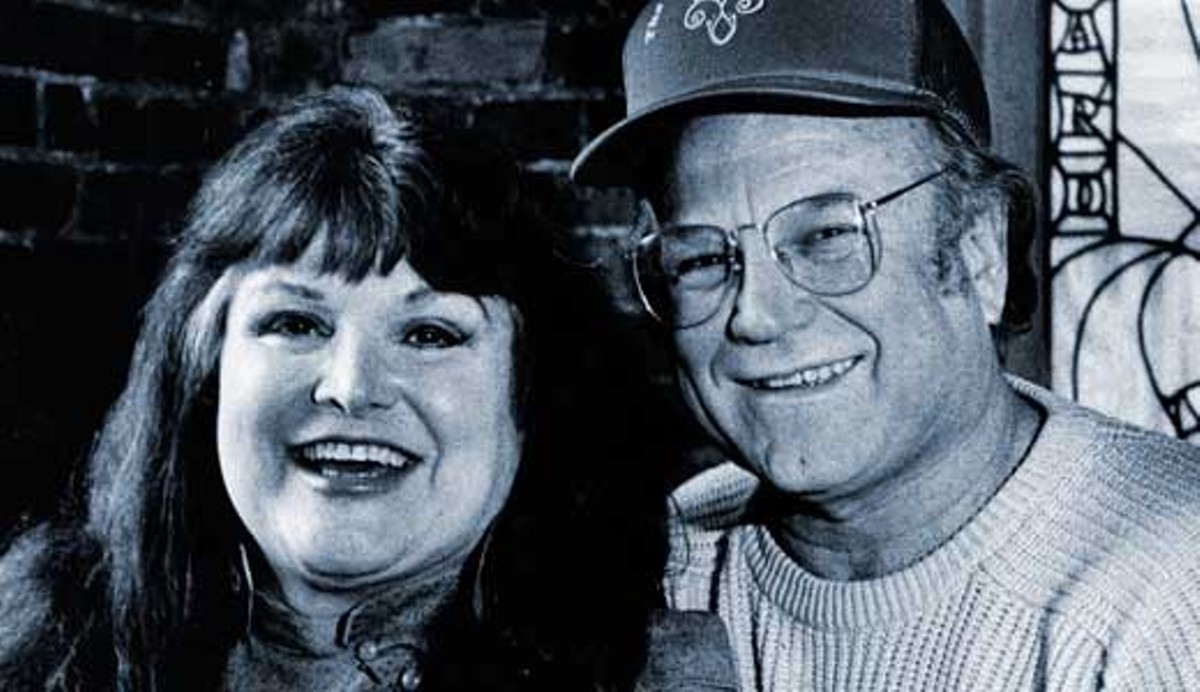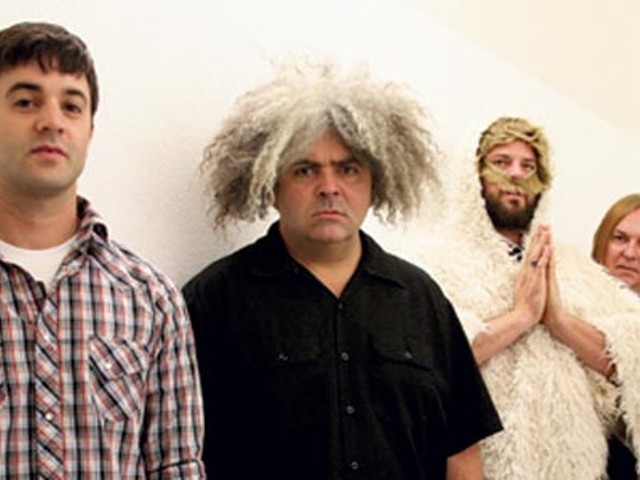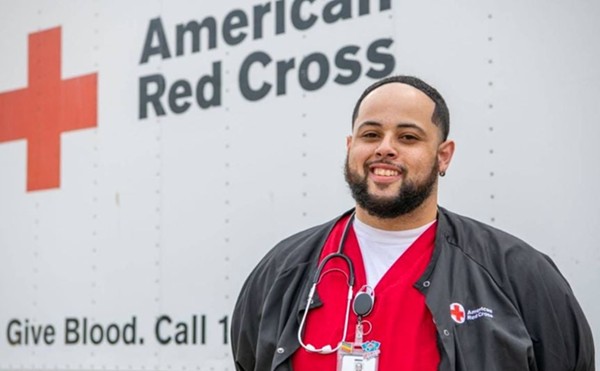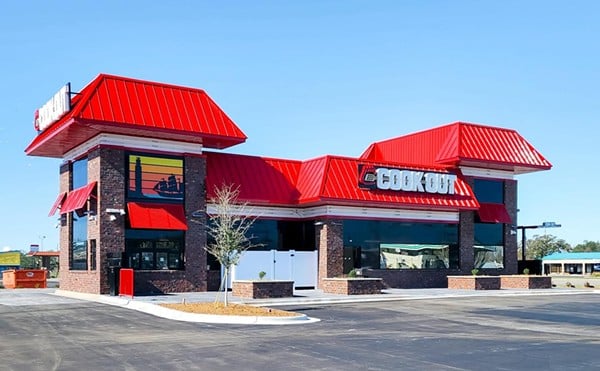Ken Pyle sits on the front porch of his two-story home in downtown New Albany, sipping fizzy yellow beer from a milk glass and sporting a black T-shirt that reads, “Be Joyful and Peaceful.”
A question has just been asked of Ken and his wife Sheila: “How has The Rudyard Kipling survived for 25 years?”
The truth is, even though they conceived, created and nurtured the restaurant and live arts venue, they aren’t quite sure how it has endured for so long. It just has. Somehow. And remarkably, they aren’t trying too hard to find the answer.
“This is what we’re into,” Pyle says, pointing to the T-shirt.
The Rudyard Kipling has always been a place a band or theater company or poet could call if they wanted to perform. It’s that simple: The artist promotes the show and performs for 100 percent of the take at the door. On the back end, the Pyles make the place run, with Ken often pouring drinks behind the bar, and Sheila cooking up her famous burgoo in the kitchen.
Such a concept isn’t built to make money — or at least not a lot of it.
And yet the Rud survives, one performance at a time. These days it’s only guaranteed to be open Fridays and Saturdays; other openings depend on whether there is a performer available.
Getting back to the question of how The Rudyard Kipling has managed to keep its doors open for 25 years, Ken recalls that there were times when the staff would go long stretches without being paid, working on tips alone to help keep the Louisville landmark afloat. Finally, he offers this explanation for the Rud’s endurance: “We’ve just had a lot of gifts — namely, the friendships. We made it because of the generosity of the community.”
For example, back in 2003, local musician Ray Rizzo orchestrated the first-ever benefit for the Rud, which included the production of a two-CD set of music by artists that had played at the establishment. The concept was called the Motherlodge, and it became a running theme for the Rud going forward.
“I remember at the time a few people, one of whom was a musician, questioned the soundness of the idea,” Rizzo says. “‘Why do a benefit for a for-profit business?’ they asked. To me, it was a sad indicator of how confused things had become. Nonprofit this, nonprofit that — I didn’t think the Rud had ever run at a profit. It was about giving thanks and helping an institution that had helped us.”
Rizzo’s Motherlodge project is named after a Rudyard Kipling poem of the same title. It embodies an ideology the poet described and which the Rud has embraced over the course of its existence. To oversimplify it, the poem describes a place in which everyone gets along.
According to Sheila, it describes people “who perhaps don’t mix it up too well out in the world, but when they get inside the Motherlodge they are all equal and friendly and respectful of each other. The Motherlodge is just a wonderful family. So Ray and his friends came up with the idea that the Rud is like that. All kinds of folks are welcome.”
In celebration of the venue’s 25th year, the Motherlodge moniker has been resurrected in Louisville as the name of this weekend’s birthday bash, which will include three days of food, music and other entertainment. And just as before, Rizzo is the brainchild behind the event, along with his wife, Traci Timmons.
Over the years, many other champions of the Rud have stepped up to help the business maintain — poet Ron Whitehead, My Morning Jacket’s Jim James, the late Tim Krekel; too many to name, the Pyles acknowledge. People they barely knew were trying to help the Rud keep going in times when, as Ken puts it, they were “in deep doo-doo.”
“Actually,” Sheila says with a smirk, “it’s been in trouble since we opened the doors.”
Greg Maupin, of Le Petomane Theatre Ensemble, considers the Rud the home base for his project; he loves the place and has often worried it will close. “I don’t think it’s a business model someone could pull off on purpose,” he says, adding, “It’s based on goodwill instead of the bottom line.”
Paul Moffett, a singer-songwriter who also publishes the free monthly Louisville Music News, migrated his open-mic night to the Rud in 1985 not long after it opened. “It was always a place where if you wanted to put something together and play, you could,” Moffett says. “(Ken and Sheila) set up their own personal vision of what it would be, and then they looked for people to populate it.”
Singer-songwriter Danny Flanigan was in a punk band called Hopscotch Army when the Rud opened its doors and began its mission. Flanigan would go on to host “The Listening Room” there for a number of years in the 1990s — a regular performance series during which talking and smoking were prohibited.
“The same thing was happening in Nashville every day, but it didn’t happen in Louisville,” Flanigan says. It was a night in which “people shut the fuck up and listened.”
The concept of a place like The Rudyard Kipling in Louisville actually predates the Rud itself by quite some time, but it must be noted that Ken and Sheila Pyle were at the heart of it even then.
Both performers and songwriters, they met in 1966 and married a few months later. Back in the day, the pair could often be found at a now-defunct blues bar near Mid-City Mall called The Shack. It wasn’t long before they decided to buy the blues dive, renaming it the Roundtable Theater.
The place was liberal in a time when liberal could be volatile, and it drew a varied clientele. A wide array of music and art was presented there, much like the Rud today. Eventually the Pyles renovated the club and renamed it the Storefront Congregation. It gained a reputation as a top music venue, hosting acts like Ralph Stanley, but they had trouble getting a liquor license, which compromised its success.
Then, in 1974, the couple moved to Berea to care for Sheila’s aging parents. They sold the Storefront Congregation with the hope of one day continuing their dream of operating an arts venue dedicated to artists and those who appreciate the arts.
Two years later, they returned to Louisville. By that time, property values in the Highlands had skyrocketed due to post-tornado renovations and other factors, and so they set their sights on staking a claim in Old Louisville. They purchased a home on First Street, and began looking for a new venue space.
It took several years, but eventually they decided on the spot at 422 W. Oak St., then home to the Crosstown Café, which, like much of the neighborhood, was struggling.
Their hopes were buoyed by a push (or at least talk of one) to revitalize Old Louisville — they saw it as a great time to get in on a rebirth. They bought the property for $55,000 and spent another $200,000-plus to completely renovate it.
“We were under the delusion that the city was going to focus on Old Louisville,” Sheila says. “People were coming in and renovating houses in Old Louisville, but it never happened that the businesses were renovated. Oak Street has not to this day been made vital and safe and new.”
In a story about the grand opening of the Rud, The Courier-Journal referred to the area around Fourth and Oak as “Fourth and Fellini,” relating to the bizarre characters from the films of Italian director Federico Fellini. About a year before Ken and Sheila bought the Oak Street property, it was the scene of a murder.
Despite the rough neighborhood, Ken says he knew there was something special about the building. In the years before buying the place, he recalls curiously “poking his head into” the property several times upon seeing a sign that said “under new ownership.”
“The only sign I saw said, ‘Girls, girls, girls,’” jokes Sheila, referring to the fact that the building was at one time home to a strip club.
A Courier-Journal story from March 28, 1984, which appeared under the headline “Oak Street’s struggle for redevelopment,” details the city’s would-be efforts to improve the neighborhood. Treyton Oak Towers was believed to be at the center of the revitalization, which included commercial development that would bring Oak Street to a new level of prosperity as part of a city-guided task force effort.
It was never fully realized.
“There has been a lot done,” Ken says. “It’s just not enough. The focus on downtown has been great, but we’ve been through three or four Oak Street development plans. We all keep agreeing on the same thing, but the money is not there to make it happen.”
And to this day, surrounding development — or lack thereof — remains an Achilles heel for The Rudyard Kipling; many people won’t make the trek downtown to attend shows there because of the neighborhood’s lingering bad reputation.
“It’s always been about the same; it never quite shakes (the reputation) off,” says Paul Moffett, who recalls playing gigs there in the early days. “If you were feeling daring after a gig back in the ’80s, you’d go to the (nearby) Steak and Egg Kitchen and watch the traffic.
“But I never had any trouble down there. People from New York would probably feel right at home there.”
Some would argue the affinity performers have for the Rud stems in part from its physical characteristics. Close confines bring the audience closer to the performance, whether it’s a reading, a concert or a play. And it’s cozy because, well, it was once someone’s living room.
The property started as a private residence built in the 1830s, and it remained so until the 1940s. The section of the building that eventually served as several businesses — including Crosstown Café and the seedy show club called Post Time II — was added during the 1940s. When the Pyles renovated the place, the entire structure underwent immense change.
The Rud has a unique bi-level layout, with the bar/restaurant area in the lower level, and the performance room in the upper level. The former, which the Pyles have always referred to as the “gazebo” area, sits where the lawn of the house originally existed. The performance room — known also as the “parlor” — is located in the original residence.
Inside the main part of the parlor, they discovered more than they bargained for during renovations: “There were three sets of walls and ceilings,” Ken says. “They just kept adding ceilings and walls to cover up damage that had been done.”
As a result, it was necessary to strip down the interior to its bare brick walls, which remain exposed to this day.
“I think musicians like way the sound ricochets off the brick,” says Sheila. “And we didn’t do any painting; we just stained whatever wood was left, so it’s kind of dark.
“It’s like a shotgun house, so there are fireplaces against the walls because those used to be rooms one after another. And there’s a mantel, and that’s folksy and warm and informal. Also, you can peek out the windows and look at the people who are dining or drinking at the bar, and that’s sort of folksy too.”
The fact that the audience is seated so close to the stage is also unique, notes Sheila, adding, “I think the musicians like that.”
“I do too!” shouts Ken, who has gone inside the house to look for something.
It’s a point on which many local musicians agree.
“It’s a great room,” says Louisville musician Brigid Kaelin. “I like that the audience is on three sides, so you have to really move around on stage to engage everyone.”
Le Petomane’s Maupin, whose theater company once staged a play about the venue, says the odd layout adds a unique element to work with, something unlike a standard theatrical stage. But like many, he too credits the proprietors and staff for making the venue feel like home.
“They are unrealistically supportive,” he says. “It’s silly, frankly. We don’t know what they’re thinking.”
And according to Danny Flanigan, the room adds a crucial element to the art being performed.
“When you have a band or act or artist or a poet,” he says, “if they are taking their art seriously and doing their thing, they just have to mean what they’re doing — that room supplies the next part. I think it’s the spirit of Ken and Sheila; the room is just helping you out.”
And so the Rud now celebrates its 25th birthday; in November, Ken will turn 70, and Sheila is now 78. Both have dealt with health problems in recent years. They aren’t sure how much longer they can continue operating the business they love.
On one hand, it’s easy to believe the old cliché that all good things must come to an end, but at the same time, it’s difficult to imagine Louisville without the Rud and, especially, the Rud without Ken and Sheila.
“They’re an institution,” Moffett says. “Twenty-five years is a long time to do anything.”
On the Rud’s website, there’s a plea from Ken and Sheila, who are desperate for someone to purchase their beloved business. It reads in part, “Now it’s time for brave entrepreneurs to step up and take this cup from us.”
Which brings us from “How has the Rud survived?” to “How will the Rud survive?”
Over the years there have been countless rumors about the Rud shutting its doors, and Ken and Sheila suggest any number of them could have been true; it’s been a shoestring operation since its inception. He notes that selling their house on First Street a few years ago boosted their budget and helped them keep the place open longer, even if it didn’t exactly make the operation a cash cow.
“I was $54 overdrawn today,” Ken says, shaking his head.
But somehow there’s always another show or play or benefit to help pull things through; it’s not as if shows aren’t still successful there. Earlier this year, the Health and Happiness Family Gospel Band took the stage at the Rud on a Friday night and packed the house. And Ken and Sheila recall a recent theatrical performance on a Sunday afternoon that turned into a twin bill due to the sheer number of people who turned out.
“People were lined up out into the street,” Ken says. “It was great.”
The acting company asked if they could sell additional tickets and perform the play twice to a second audience. The staff at the Rud was game to work a long shift to provide the opportunity, and so they all stayed.
“I said, ‘If you want to have a play, we’ll have a play,’” Ken says.
Only at The Rudyard Kipling.
Many have suggested that if the room could be somehow airlifted to the Highlands, it would probably last another 100 years. That may be true, but would it still be the Rud? It seems part of the mystery is tied to the location.
The business has been up for sale for a while now, yet there have been no serious offers. Ken admits, however, that he’s been relying on word-of-mouth, rather than officially listing his beloved business on the real estate market.
“We also would trade,” he says. “Although I don’t know what we would trade for. It’s just probably a little more than we can handle for too long. I enjoy it, but I’m sure there’s somebody younger that could handle it better.”
At this point, a few local champions of the Rud have voiced an interest in keeping the venue alive. Flanigan says he has talked with investors about buying the place with the dream of continuing Ken and Sheila’s vision, but has had no success, and he can’t afford to buy the business himself.
And then there’s Ray Rizzo, who stepped up to help save the Rud years ago with his Motherlodge benefit. Since then, Rizzo has kept the Motherlodge concept alive, transforming it into a live arts exchange promoting music, theater, literature and other artistic disciplines in both Louisville and New York City, where Rizzo and his wife now reside much of the time.
“As far as Traci and I are concerned, the picture for the future is that from here on out, each spring the Rud will host Motherlodge Louisville, and each fall we’ll throw a birthday party,” Rizzo says. “Beyond that, I can only speak from my own hopes and dreams, which are voiced loudest from out of my butt and will probably make a few people choke on their burgoo.”
Upon further explanation, his hope is this: If someone does not step up to purchase the Rud, Motherlodge would eventually take it over and develop it as an art space with a New York City “sibling” venue. He and Timmons would build an apartment upstairs in the building and live in town a few months of the year.
“And actually, it’s a dream that I know at least two other art groups would like to do as well, so I figure there’s enough people keeping the Rud in mind to suggest that it will be whatever it wants itself to be,” he says.
Meanwhile, Ken and Sheila seem content to take it a day at a time. As they sit together on their porch talking about old times at the Rud, they spontaneously break into a song Sheila wrote in the late 1970s called “Sweet Evening Breeze.” Their voices harmonize beautifully.
They aren’t stressed when talking about the future, because somehow things always work out. Someone steps forward to help, just as they’ve helped the artistic visions of so many over the last few decades.
“It gives you a little faith in the future,” Sheila says.
Ken certainly believes things are looking up, noting that he sees a society in which there is an outpouring of goodwill based on necessity. Perhaps this means more Rud-like efforts are waiting to be born.
“It used to be about competition, and now it’s about cooperation,” he says. “What a concept.”
Motherlodge:
Schedule of Events
Thursday, Oct. 1
The Rudyard Kipling hosts benefit show and auction for Center of Hope Kitchen — hosted By John Gage
7 p.m.: Reception / Buffet dinner served by Chef Timothy Tucker
7:30: John Gage Intro — Shelby Park Soul Stew
8:15: Brigid Kaelin (and guests)
9-9:15: John Gage
9:15: a.m. Sunday
10: Yim Yames
Cover: $20 for dinner, show and auction; $15 for show and auction. Charity auction will happen sometime after 9 p.m.
Friday, Oct. 2
Bar stage hosted by Alanna Fugate
7-7:45 p.m.: Funky Ground Water
7:45-8:15: Alanna Fugate/Mike Dufresne and Co.
8:15-9:30: Java Men (PARLOR)
9:30-10: Alanna Fugate/The Indicators
10-11: Arnett Hollow
11-11:30: Alanna Fugate/J.P. Lebangood
11:30: Tyrone Cotton
Cover: $10
Saturday, Oct. 3
Bar stage hosted by Alanna Fugate
3 p.m.: Afternoon Children’s show with Traci Timmons, J.P. Lebangood and others
5: Ray Rizzo
6: Today The Moon, Tomorrow The Sun
7-7:45: Misha Feigin
7:45: Alanna Fugate/Reginald Bareham
8:15-9: John Mann
9-9:30: Alanna Fugate/Danny O’Day
9:30-10:15: Big Car Back Seat
10:15-10:45: The Indicators Improv
10:45: Tim Krekel Tribute with various artists
Cover: $10
Visit www.motherlodge.com or www.therudyardkipling.com for more information.







